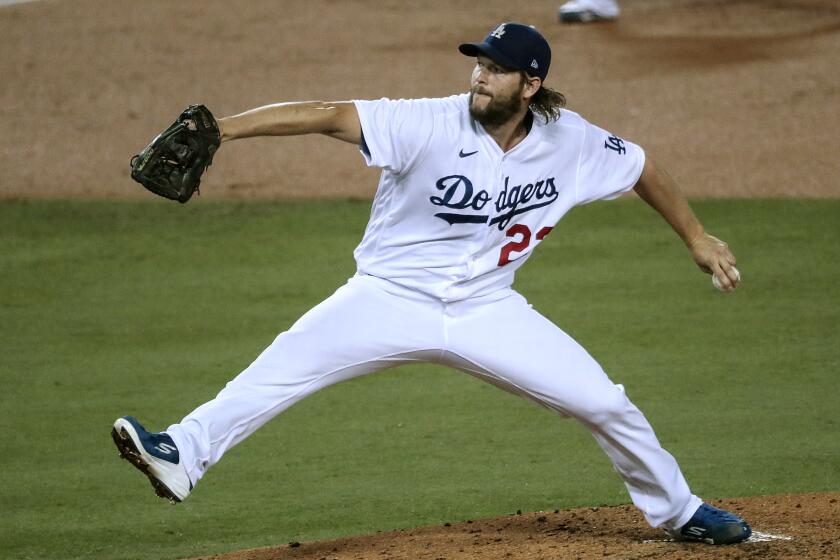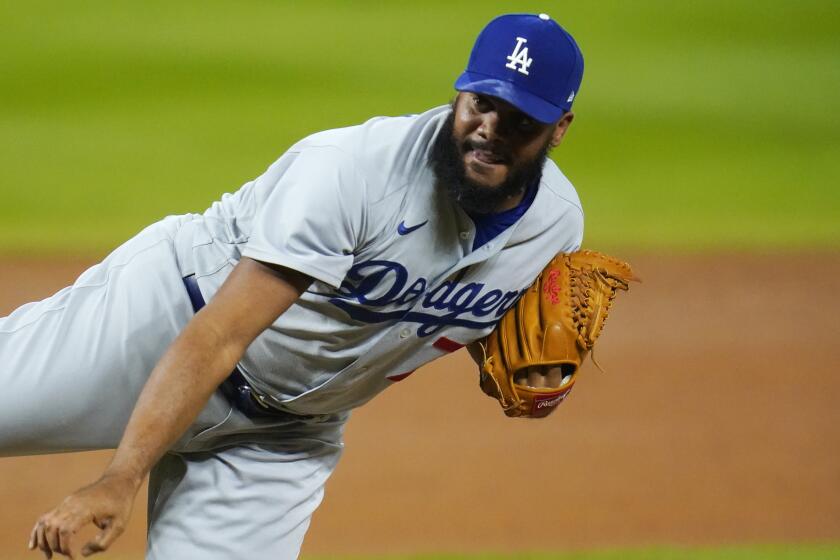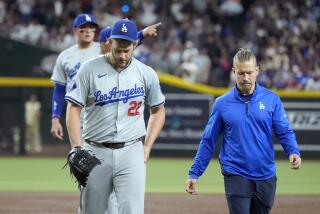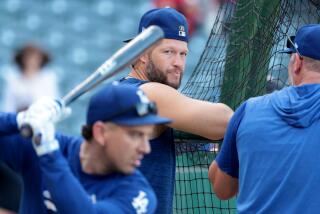Clayton Kershaw’s not-so-secret weapon rendered Brewers helpless in Dodgers’ win

After the first start of Clayton Kershaw’s resurgent 2020 campaign, a scoreless 5 2/3-inning outing against the Arizona Diamondbacks that launched his best regular season in years, manager Dave Roberts made an observation.
Yes, his 32-year-old ace had reversed an annual decline in velocity, showing a rare uptick in fastball speed following an intense offseason throwing program that included a trip to the Driveline training center in Kent, Wash.
But it wasn’t the radar gun Roberts paid the most attention to that day, or in any of Kershaw’s starts since. Instead, he knew it would be the repeatability of Kershaw’s command — to locate the ball and shape his pitches exactly how he wanted — that would matter most to the left-hander’s success.
Never was that clearer than in Kershaw’s scoreless eight-inning spectacle Thursday, when the former most valuable player set a postseason career high with 13 strikeouts to help the Dodgers complete a two-game wild-card series sweep of the Milwaukee Brewers in a 3-0 win.
Clayton Kershaw pitched one of the best games of his career against the Brewers on Thursday, but he needs to show he can win the final game.
He didn’t overpower opposing hitters with a fastball that still only tops out around 93 mph — harder than anything he threw last season, but nonetheless below average in today’s game.
He out-executed them instead.
From the outset, Kershaw hit almost all his spots, firing a first-pitch strike to 24 of 27 hitters he faced. With almost every count in his favor, he sequenced in breaking balls and mixed in his evolving arsenal. Throughout the night, his deceptive delivery made his pitches all look roughly the same — until the moment they broke in opposite directions as they crossed home plate.
After trying to rediscover himself the last two seasons, when inefficiencies in his game contributed to several postseason failures, Kershaw displayed a mastery of the craft that left those watching in awe.
Roberts: “[His slider] had depth. He was going glove side with it, traditional, which he has always done. Then he was going arm side with it. Then mixing in the curveball.”
Catcher Austin Barnes: “The slider was really nice, the curveball was keeping guys off balance and he was putting the fastball where he wanted. It was just a Kershaw outing. It was awesome.”
Brewers manager Craig Counsell: “His slider was as good as I remember it. The swing and miss on the slider was really impressive. It’s late and it’s hard movement and it comes out just like his fastball. He’s got it going really good.”
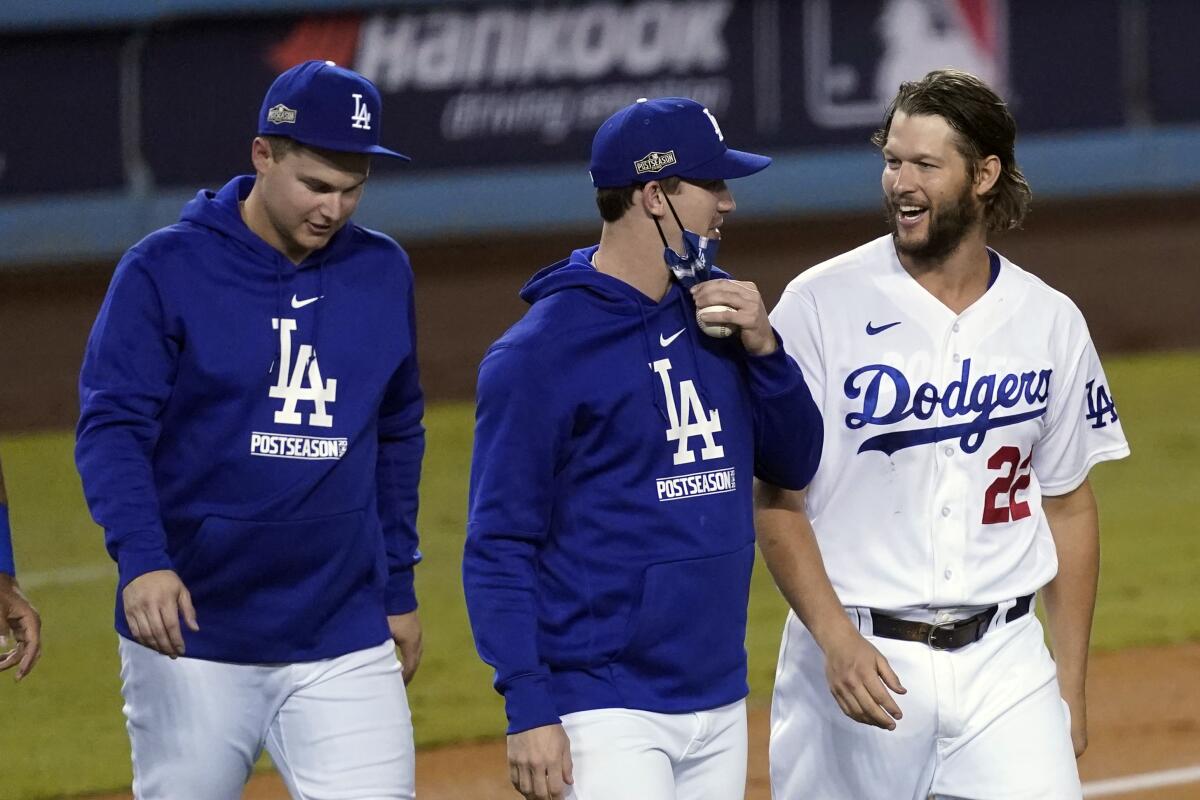
Indeed, Kershaw’s success often revolves around the effectiveness of his slider. At its best, it’s a pitch that zips toward the plate on the same path as his four-seam fastball before falling off at the last second to dip beneath empty swings. When it’s not working, however, it leaves Kershaw without a reliable putaway pitch, forcing him into longer at-bats that increase the chances of a mistake.
In his regular-season finale last Friday, a frustrating four-inning start in which he allowed four runs (though only one was earned) and two homers against the Angels, Kershaw felt the latter taking place.
“I just really didn’t feel like I had the arm speed to create the movement I needed to on that pitch,” he said. “I was getting a lot of foul balls, and even the good ones were getting foul tipped and things like that.”
So, with the benefit of an extra day of rest before his Game 2 start, the man of meticulous routine took the rare step of tweaking his. He left himself more time for physical recovery. He focused more on making sure his mechanics felt right.
“I think that probably helped a little bit,” he said. “Just to get that arm speed back you need to get that torque on that slider.”
In years past, he might have resisted such a move.
Kenley Jansen’s underwhelming stuff against the Brewers in Game 1 opens the door for Brusdar Graterol or Blake Treinen to take over as Dodgers closer.
“I’ve been known to be pretty stubborn,” he said. “I just kind of do the same things no matter what in between starts, no matter how I’m feeling.”
But at this stage of his career, he’s become willing to “figure out some things based on how you feel and actually have to think a little bit.”
“Which is no fun,” he added, “but I think it maybe will benefit me in the long run.”
Whatever he did, it worked to perfection. His slider alone netted 20 swinging strikes against the Brewers, more than he’d had in any game all season. His fastball and curveball provided complementary balance in a three-hit, one-walk performance. And in matching the longest postseason start of his career, he needed only 93 pitches.
“Sometimes swing and miss is important,” he said. “But the biggest thing is just being efficient, being able to get deeper in the games. Throwing eight innings was awesome. It’s a good first step for sure.”
***
As a rookie in 2008, Kershaw threw a slider less than 1% of the time. He’s gradually increased usage of the pitch, and has thrown in 40% of the time over the last three seasons.
CLAYTON KERSHAW’S PITCH USAGE BY SEASON
2020: Fastball (41%), Slider (40%), Curve (19%)
2019: Fastball (44%), Slider (39%), Curve (16%)
2018: Fastball (42%), Slider (41%), Curve (16%)
2017: Fastball (47%), Slider (34%), Curve (17%)
2016: Fastball (50%), Slider (33%), Curve (16%)
2015: Fastball (51%), Slider (28%), Curve (18%)
2014: Fastball (55%), Slider (29%), Curve (14%)
2013: Fastball (61%), Slider (25%), Curve (13%)
2012: Fastball (62%), Slider (23%), Curve (11%)
2011: Fastball (65%), Slider (26%), Curve (5%)
2010: Fastball (72%), Slider (20%), Curve (7%)
2009: Fastball (70%), Slider (8%), Curve (17%)
2008: Fastball (72%), Slider (0.4%), Curve (23%)
More to Read
Are you a true-blue fan?
Get our Dodgers Dugout newsletter for insights, news and much more.
You may occasionally receive promotional content from the Los Angeles Times.

